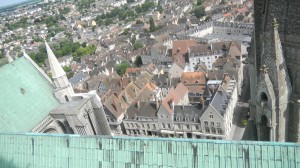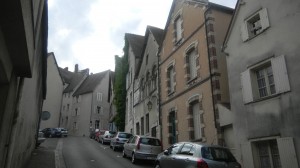It was the worst disaster imaginable. In 1194 a fire ravaged the city of Chartres, and all of its cathedral except the west facade burned to the ground.
Chartres was the center of the cult of the Virgin Mary. People at first thought that the fire was a sign that she had forsaken her sanctuary because of humanity’s sins. But Chartres in 1194 was a special town in a special time.
The sacred tunic that Mary wore when Jesus was born was saved. Emperor Charles The Bald had given it to the city of Chartres in 876. Many miracles, including the repulsion of a Norman invasion in 911, were attributed to it. Mary’s cult grew in the 12th century–and so did the position of women. Contact with the Middle East via the Crusades and pilgrimages, and new urbanization in Europe opened people’s horizons beyond a strictly alpha-male world dominated by kings, knights and bishops. A humane side of Christianity was developing that was balancing earlier Romanesque views of Christ as the king and final judge.
But Chartres had a worldly side that was just as inspiring as its faith.
Chartres was a key center of Europe’s cloth trade. Its industrious people hosted trade fairs that connected merchants all over Western Europe, and they built homes like the ones in the above picture (though the 2nd home from the right looks newer). Since Chartres’ cloth trade was associated with Mary’s tunic, people’s economic and spiritual lives were tightly interwoven. The 4 great commercial fairs coincided with the 4 great feasts for the Virgin, which attracted many pilgrims to the cathedral. The fairs rollicked next to the cathedral, and many ordinances were passed to prevent boisterous market life from spilling into the sanctuary. Chartres’ economic and spiritual life was too vital for its people to be in despair for long.
They soon concluded that the Virgin allowed the cathedral to be destroyed, not because she was abandoning the town, but because she wanted a better home in it. Chartres was one of France’s richest dioceses, and her people donated money to build a new cathedral in a burst of religious zeal. At the same time, the king of the Khmer Empire was building a newer and bigger home. Both of these construction projects were two of the greatest achievements in world cultural history. We’ll look at them side by side in the next few posts. Or if your spirit is strictly Gothic, you can fly directly to Chartres Part Two.
You can see the origins of Gothic style in St. Denis,
a great example of early Gothic style in Laon Cathedral,
and more of medieval Europe’s lusty town life in medieval cities.



Comments on this entry are closed.